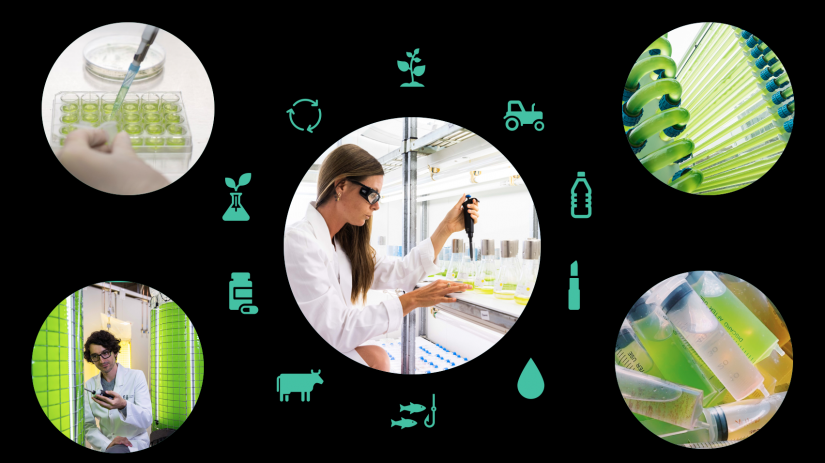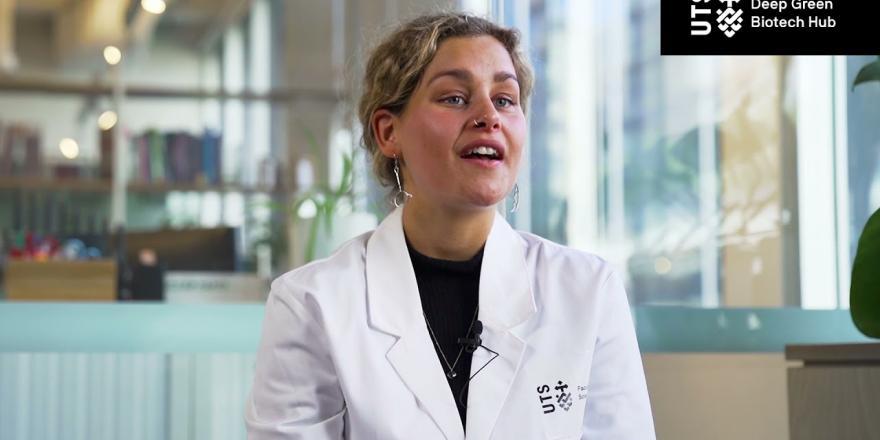We've curated an online, syllabus-mapped sustainability resource for Stage 4 - 5 High School Science Students that develops students' understanding of the biotechnological applications of science to address climate change and sustainable development.
High School Algae Education Resource

Amazing algae online unit: Innovating with biology for a sustainable future
This Stage 4 and 5 Science online unit aims to give students an appreciation of the natural world, and the ways in which biological organisms, like algae, played an important role in the development of the Earth as we know it today.
About the unit
The unit incorporates videos, quizzes and problem-solving design activities to enhance students’ understanding of the ways in which biological processes can be harnessed with technology to help solve the contemporary sustainability problems facing their future.
The unit links in with the Stage 4 and 5 Science Curriculum, incorporating outcomes from Values and Attitudes, Working Scientifically, Living World, Earth and Space and Chemical World, with a strong-focus on the ‘Sustainability’ cross-curriculum priority. A teaching guide is provided that maps the resource activities to relevant NSW Science Syllabus 7-10 learning outcomes.
Program use:
- Homeschool and remote-learning students
- Self-directed class learning activity or homework
- Class-group activity
Program objectives:
- Enhance student’s awareness of the transformative potential of algae and biotechnology to create solutions for contemporary sustainability problems (Main Curriculum Links: SC4-2VA, SC5-2VA, SC4-8WS, SC5-8WS, SC5-15LW)
- Demonstrate the role biological organisms have played in important developments in Earth’s history, and how they are directly relevant to students’ lives in the past, present and future (Main Curriculum Links: SC4-12ES, SC4-13ES, SC4-15LW, SC5-14LW)
- Enhance students’ appreciation of the importance of scientific discovery and technological developments for innovation (Main curriculum links: SC4-1VA, SC5-1VA, SC4-3VA, SC5-3VA)
Format: Online via Deep Green Biotech Hub webpage.
Who is it suitable for
Year 8 and 9 (Stage 4 and 5).
Duration
The unit has been designed to be flexible according to teachers needs - depending on the activities chosen, this unit can be taught as a single-lesson (approx 30 mins) activity or a multi-lesson (approx 1.5 hour activity) , or it can be assigned for homework.
Cost
The resource, including a PDF Teacher's Guide, are accessible free of charge.
Register your interest
Interested in this program?
Complete the below enquiry form, and we'll send you:
- A PDF teaching resource with mapped syllabus links
- The access link to the program 'Activity' webpage
The Algae Innovation Challenge

Hello and welcome to the NSW Deep Green Biotech Hub here at the University of Technology Sydney’s Climate Change Cluster.
Here we have the incredible privilege of working alongside scientists, businesses and startups who are using algae to create solutions for many of the big sustainability challenges facing our world.
It’s an exciting environment to be in, one that is full of possibility, collaboration and drive to create a better future for people and the planet. We are so thrilled that you are just as excited about and interested in algae as we are!
So, how do scientists at the UTS Climate Change Cluster use algae to drive innovation in the real world? Today I’m going to show you some of the algae research facilities here at UTS and talk you through the process.
Scientists estimate there are over one hundred thousand different species of algae on Earth, which can be as genetically different as you are from a mosquito. So, identifying the right strain of algae for the job is a really important first step.
Of the thousands of algae species in the environment, roughly only 500 have been isolated and grown in laboratories. Here R the UTS Algae Culture Collection we have roughly 100 different species that scientists use for biotechnology and research.
One of the most important roles that scientists play in algae innovation is identifying the right algae strain and ideal growth conditions to maximise the production of the desired algae compounds that would like to use.
Algae cells are made up of oils, proteins and carbohydrates and the amount of these compounds differs across different species of algae. Some might produce more oils that are useful for bioplastic production, whereas others might produce other useful chemicals like pigments, enzymes or vitamins for use in the pharmaceutical industry.
Using the latest sensor, robotics and artificial intelligence technology, scientists can predict and adjust the amount or light, nutrients or C02 provided to the algae as well as the pH or temperature of their growth conditions. Alternatively, scientists can use genetic techniques to alter the DNA of the algae to produce the compounds they need.
Once the right strain has been identified, a few milliliters of algae can be grown into several hundred litres in large outdoor ponds or devices called photobioreactor. Which essentially means a “light-powered life grower”.
These photobioreactors can get their light from the sun, like these ones here growing on the rooftop of the UTS Science building in Sydney City. This is an excellent way to save space and land, so that growing algae doesn’t compete for housing, agriculture or habitat
Alternatively, algae can be grown indoors or underground using artificial light like these ones in the UTS basement.
This bubbling gas you can see is carbon dioxide - the gas that algae and all plants on Earth use for photosynthesis. One of the emerging, exciting applications of algae is to harness this photosynthetic process to capture excess carbon dioxide being released by humna The algae that is grown using this captured C02 can then be harvested and used to make products with a lower carbon footprint than those made using fossil fuels.
Once they have enough algae, scientists go back to the lab, and work with engineers, chemists and designers to harvest and extract the compounds they need to turn into products. Here we have a plastic extruder that melts algae-based bioplastic polymers into pellets. These can then be moulded and shaped to be tested for durability and strength.
To create a more sustainable world, we need to reimagine and reinvent the way society has produced and consumed materials for the last half century. Developing algae innovations is a continuous process of trial and error, testing and refining. We need scientists and engineers to run experiments and optimise the process, but we also need creative thinkers, innovators and entrepreneurs to look to nature for inspiration and imagine a Deep Green future with algae.
This is where you come in, the next generation of changemakers. You might not have access to the technology here at UTS, but you do have the bright, bold and innovative ideas that the world needs.
Good luck in the Algae Innovation Challenge, we can’t wait to meet the young algae entrepreneurs of the future.
Amazing Algae goes live!
In June 2021, NSW Deep Green Biotech Hub teamed up with science education extraordinaires Fizzics Education and Virtual Excursions Australia, to run the Algae Innovation Challenge, for year 7-10 students during National Science Week 2021.
Students were invited to brainstorm and present their own innovative algae ideas that help to meet the resource demands of a growing population in a way that minimises, or even reverses, human impact on ecosystems and the climate.
Learn about our 2021 Finalists
